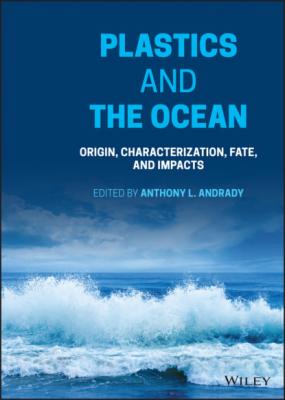Plastics and the Ocean. Группа авторов
Читать онлайн.| Название | Plastics and the Ocean |
|---|---|
| Автор произведения | Группа авторов |
| Жанр | Химия |
| Серия | |
| Издательство | Химия |
| Год выпуска | 0 |
| isbn | 9781119768418 |
Table 2.1 Classes of plastic additives, typical loadings, and percent share in plastics production.
Source: “Typical loadings” are the max and min ranges reported by Geyer et al. 2017, Zweifel et al. (2001), Hahladakis et al. (2018), Andrady and Rajapaske (2019), and Ambrogi et al. (2017).
| Type | Additive Class | Typical loadings (wt%) | Share (%) | Market size (USD million)a | Examples | Purpose |
|---|---|---|---|---|---|---|
| Plasticizers | Functional | 10–70 | 34 | 1550 | Phthalates, tris(2‐chloroethyl) phosphate | Soften polymer and make more flexible |
| Flame retardants | Functional | 3–25 | 13 | 7000 | Poly(bromo diphenyl ethers), organophosphorus | Prevent ignition or flame propagation |
| Antioxidants | Functional | 0.05–3 | 6 | 5770 | Hindered phenols, alkylphenolsb, phosphitesc, lactones, hydroxylamines | To prevent discoloration and degradation during processing, use, and weathering |
| Heat stabilizers | Functional | 0.1–8 | 5 | 3630 | Dialkyl maleates or laureates and dialkyl mercaptides of tin in PVC formulations to retard HCl evolution during processing | To prevent thermal degradation during processing |
| Fillers | Fillers | 1–50 | 28 | 10 000 | Clays, silica, glass, chalk, talc, asbestos, alumina, rutile, carbon black, carbon nanotubes | To provide mechanical reinforcement or formulation cost reductions |
| Impact modifiers | Functional | 0.5–30 | 5 | 3280 | Acrylonitrile butadiene styrene (ABS), acrylonitrile styrene acrylate (ASA) | To increase flexibility and impact strength to meet physical property requirements of rigid parts |
| Colorants | Colorants | 0.25–5 | 2 | 37 000 | Cadmium, chromium, lead, and cobalt compounds, titanium dioxide, carbon black; organic dyes | To impart a desired color on the finished product |
| Lubricants | Functional | 0.1–3 | 2 | 4558 | Waxes, oils, long‐chain esters of polymeric alcohols | Allows easier processing of the plastic (i.e., lower temperatures, faster processing times) |
| Light stabilizers | Functional | 0.05–3 | 1 | 373 | Hindered amine light stabilizers, benzo‐phenone light‐absorbing compounds | To prevent degradation of the plastic upon exposure to light sources |
| Other (anti‐static, anti‐microbial, etc.) | — | — | 4 | — | Silver, thiabendazole, aliphatic amines | — |
| Monomers, catalysts | Unintended Additives | — | — | — | Bisphenol‐A, styrene, antimony | Unreacted monomers or residual catalyst left over from the polymer synthesis |
a These are market sizes for all applications, not just in plastics.
b The majority of alkylphenols (APs) found in the environment are degradation products of surfactants, not plastic additives.
c If phosphites are used, the loadings can be higher than the range indicated.
2.2 Functional Additives
2.2.1 Plasticizers
Plasticizers are added to plastics to improve their flexibility, durability, and elasticity over a broad range of temperatures while also reducing the glass transition temperature (T g) and the melt flow. The dissolved plasticizer molecules, not being covalently linked to the polymer backbone (Greco et al. 2010), can migrate freely within the resin matrix. The exact mechanism of plasticization is not fully understood; however, studies demonstrate that strong association of the polymer chains with the plasticizer molecules creates additional free volume in the bulk plastic matrix, yielding a softer and more flexible material (Greco et al. 2010; Ramos‐Devalle and Gilbert 1990).
Relatively high concentrations of plasticizers are required to achieve these desired changes in plastics, accounting for 34% of the total additives used in global plastics production from 2000 to 2014 (Geyer et al. 2017). Phthalic acid esters, or phthalates, are the most widely used plasticizers. Of the reported 8.4 million metric tons of plasticizers manufactured worldwide in 2017, about 65% were phthalate plasticizer used by the poly(vinyl chloride) (PVC) industry (IHS Markit 2018), with di(2‐ethylhexyl) phthalate (DEHP) being the most widely applied phthalates in PVC (Table 2.2). Because DEHP is highly regulated, it has gradually been replaced by diisononyl phthalate (DiNP), diisodecyl phthalate (DiDP), and di(2‐propylheptyl) phthalate (DPHP). In 2015, DPHP represented 57% of plasticizer consumption in Europe (ECPI 2016). However, the high loadings and migration of plasticizers from plastic materials have led to significant concern about the effects of phthalates in the marine environment as early as 1978 (Giam et al. 1978).
2.2.2 Flame Retardants
Plastics, especially those with a high carbon content, are inherently flammable. For many resins, the most cost‐effective method for increasing fire safety is to blend a FR additive into polymer formulations
